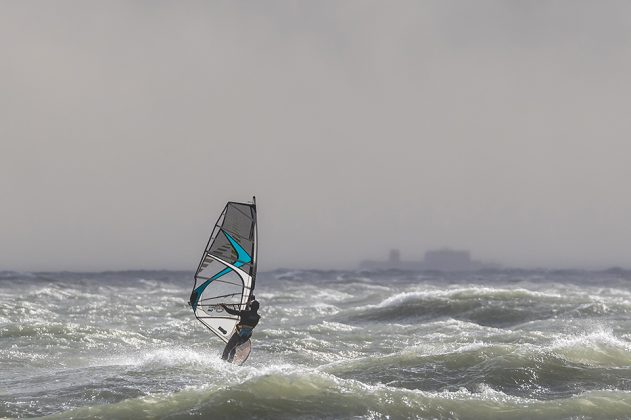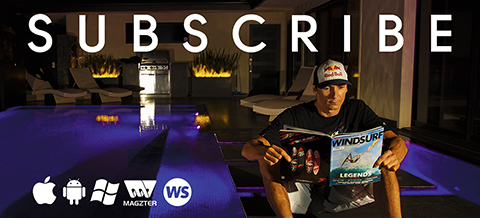ONSHORE PART 2 – REAL TALES
Words Peter Hart // Photos Bill Wyatt, Dave Gammon and PH Photography
Harty continues his exploration and explanation of sailing waves in onshore winds, this time calling on the experiences of some informed locals.
Blame it on El Nino, a bump in the jet stream or just a glitch in the natural order, but down here on the UK’s West Sussex coast the winter of 2015/16 was a classic. Between November and early February we had 50 days over force 6 and balmy temperatures – ‘balmy’ in a British winter context meaning double figures and liquid water (unfrozen!).
A run of such winds brings many things – marital tension, absenteeism, bankruptcy; but also orgasmic enthusiasm, increased understanding of all aspects of wave-sailing and meteoric improvement. Actually the last one is not guaranteed. It’s all too easy to go out session after session and run the same lines and fall prey to the same old mistakes.
The Joliffe Rd crew is an eclectic bunch. It’s essentially a band of coast-dwelling locals with various histories, who despite having to put food on tables, often managed to sail 5 times a week. In the mix there’s a smattering of pros past and present – Paul Hunt, Neil Gent, ‘Jamies’ Hancock and Hawkins and Timo Mullen.
The difference with this group is that there are no ‘us and them’ divisions. There’s a collective push. The ams feed off the good guys and via a manically active WhatsApp group, they share information and vitriolic banter hourly which is infuriating if you’re at your desk on a windy day trying to get things done (I know … turn off ‘alerts.’) But it’s interesting stuff.
Their rise has been meteoric.
As a coach you develop ideas and suggest a methodology to progress in certain areas. However, in windsurfing and especially wave sailing, there are very few absolutes. And what has been fascinating to me this winter is how different sailors have interpreted what they read, hear and see and made it work for them.
I cornered a few of them and ask them to spout intelligently about various aspects of onshore wave sailing – reading the conditions, choosing and tuning kit, staying upwind, choosing the lines they ride etc. I loosely covered some of the themes last month. Their comments don’t necessarily contradict those comments (that’s never going to happen, I have editorial control) they just express another way to cook the same goose and may inspire you to experiment.
Improvement starts with a reality check and a change of attitude.
Introducing the chosen few …
The following were selected primarily because they were in when I called – but they’re also a fair representation of the standard spectrum.
Emile Kott (EK), is a web designer by day. He sails like a pro although modesty forbids him from calling himself such. In another life he ran centres for Josh Angulo in the Cap Verdes and Simon Bassett at West Wittering so has experience in a wide range of conditions. He’s also supremely fit, so when listening to his advice, understand that he’s dealing from a full pack.
Ian Whittaker (IW) has a proper job as a builder but seems to be able to delegate at the hint of a breeze. He was British Amateur champ in 1997, scored 7th at the Da Kine pro/am even at Ho’okipa and lived in WA for 5 years. He has a ‘go for it’ style and is on the lighter side of average weight.
Paul ‘Monkey’ Metcalfe (PM), electrician, has been at it for years, lived through many design eras and is good enough to really feel and comment on the progression both of his kit and his own progress.
Dan Macaulay (DM) bleats on about himself not being a ‘natural athlete’ and therefore how hard he has to work at stuff – but actually he’s far better than he thinks he is, having sailed most of the world’s top breaks. He’s ambitious and fiercely analytical (his contribution here is the lengthiest and was edited down from pages of notes!) He runs Brandwave, a sports marketing company and despite also having a newborn, manages to get out a lot – now that in itself is a skill worth sharing.
As for the group’s vintage, I’ve seen so many ripped veterans and flabby young-uns that age is pretty irrelevant but I guess they’re all somewhere between 30 and 50.
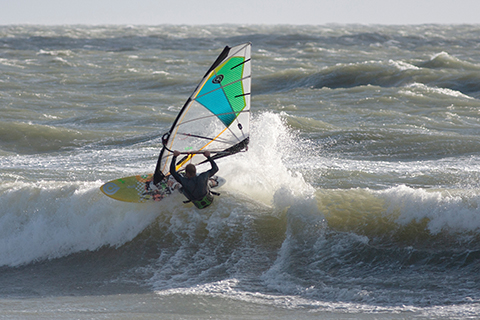
// “You have to make your turns tight in onshore winds.” Emile Kott practises what he preaches. He shortens the rail by locating straps and mastfoot as far back as possible. It’s not a set-up for the heavy-footed.
PHOTO Dave Gammon
THE DAY, THE SPOT, THE CONDITIONS
Conditions were a bit special this winter but they were still mostly onshore and therefore, by definition, messy. But ‘messy’ only compared with the imagined perfection of a mystical South Seas Isle. It seems that improvement starts with a reality check and a change of attitude.
IW “We get maybe 6 side-off days a year, and those aren’t always that good. The cold front is passing through so you usually only get 4 or 5 hours of wind. And then it’s only good if there’s a decent swell. But as soon as the wind kicks round, the waves disappear pretty quickly. Onshore winds are often better as at least they keep driving the swell.”
Most beaches don’t have the fetch or the offshore water depth to hold a swell. In the relatively shallow English Channel, it only takes one big low tide to suck the guts out of the waves. Without long, powerful swell lines, cross-off winds aren’t a lot of fun.
By common consent, a wind near enough side-shore offers the widest jumping and riding options – but be careful what you wish for …
DM “If it’s really strong, the dead side-shore wind – WNW down here – can be a nightmare. There’s not much fetch so it produces a short, reservoir type chop on the wave face, which makes riding really awkward. When it’s a little bit onshore it’s often smoother because the swells act as a steamroller and iron out the surface.”
Horses and Courses
It’s not always the case, but in a mildly competitive group especially, people will judge a session as ‘good’ when they achieve something. To that end, one of the most valuable skills is knowing what’s achievable on a given day, by clocking the exact nature of wind and wave. On the subject of wave directions, Emile speaks much wisdom.
EK “You have to work out what you’re looking at and what you’re looking for.
Wind angle is of course crucial but it’s wind angle to the wave that counts. It’s not always easy to see from the shore how much a wave can bend in around a sandbar. It only has to change direction a few degrees to give you a much better jumping or riding line.
In winter especially I’m driven more by the waves than the wind. I see with a lot of weekend warriors it’s the other way round. And as soon as the wind dips a bit, they get off the water. I just rig bigger and sometimes I’m the only one out.”
Does he have a favoured direction?
“I like to see a lot of westerly in the wind (more side than on) but it’s good practice going out when it’s more onshore. Right now I’m working on takas and I’m having more luck in onshores when there’s bit more back hand pressure at the end of the bottom turn. But when it comes to conditions, in general I’d say – be happy whatever! Go for stuff that suits the conditions. If the waves are steep and slow, go for ‘backies.’ Back loops are all about getting a vertical take-off.
If it’s windy and the waves are slopey, go for long floaty jumps or forwards.
If it’s not windy, don’t bother jumping!”
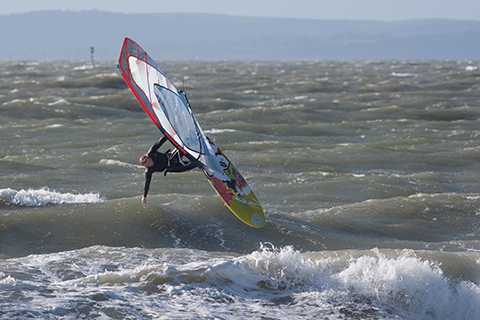
// Ian Whittaker, never one to use 2 hands where one will do, going typically wild on his quad right outside his house.
PHOTO Dave Gammon
KIT SELECTION
The whole group sail Quads. Why four fins over 3 or 2 or 1? There was no deep research. As is often the case at a certain spot, someone had a connection, (Lalo Goya in this case) and thereby followed a feeding frenzy. People are more influenced by seeing a board working well where they sail under the feet of someone they know and can relate to. If they believe, they’ll mould their style around the recent purchase.
The biggest change from the good old days has been choice of volume. They’ve all gone a lot bigger
DM I’m sailing 10 litres up per sail size than I used to. I’m 80kg and my smallest board is 85, which I use even with a 3.7. In those winds there’s so much water moving that the extra volume really helps, especially upwind. It’s better to be slightly over-boarded than over-sailed. The extra volume doesn’t effect manoeuvrability nearly as much as it used to. I’m now using combos like my 95 and a 4.7 that would never have worked in the past. The compromise is that I’ve gone for the wider tailed onshore design – it’s good for early planing, popping into jumps and slamming into tight turns – but not so great over-powered or if you want to go for a long fast bottom turn on a big wave – but we don’t get many of them.
PM (Monkey) I always went for high volume boards. I had a 95 Naish pro Wave for ages. It took me a long time to change to multi-fins. At first I didn’t get on with them at all. I guess I was a bit old school, driving off the rails and the single fin AND using a big sail. Now I stand more inboard and turn using the feet and less with the rig. One of the things I like most is how much better the Quads go upwind than my old single fin. I thought it would be the other way round.
IW My smallest board is an 86 (Ian is about 78 kg) – it used to be an 80 but that was always too small. Trying to sail down the line in onshore winds I’d carve half way and stop. Now I often use my 96 Quad when it’s really onshore. You sacrifice a bit of manoeuvrability but it means you can keep your speed up downwind through your bottom turns, and it’s easier to get out and stay upwind.
Discussing the progression of wave sailing with Finn Mullen, the editor of this fine publication, and his lesser known sibling Timo, we decided the biggest change in recent years is that thanks to bigger, faster, earlier planing wave boards, you no longer need rely on radical conditions to produce a radical performance – and that’s certainly been the case with Joliffe crew.
Board set-up
A true sign that someone is making the transition to bona fide wave sailor is when they start playing with straps, mastfoot and fins and genuinely feel the difference. Footstrap and mastfoot positions determine how much rail you naturally engage in each turn and how loose or directional the board is. As for fins – well who knows what’s really going on under there – but changing size and flex alters the radius of the turns and how the board releases. Still – different adjustments mean different things to different people.
PM (Monkey) What helped me get used to the Quads was putting the mastfoot forward. With it back it felt too skittery and the fins kept breaking out; with it forward it feels faster and more powerful through the turns, especially in chop.
Ian felt the exact same way, but Emile has a completely different take on it.
EK I bring everything back, straps and mastfoot, to shorten the rail. With the track in front of middle I can’t turn it. In slow onshore waves, you have to be able to turn tight to hit the peaks.
You might have a mental picture of Emile dropping back and pivoting the board round as if he were ‘flaring’ an old long board. It’s the opposite – he has to lean really far forward to control the nose – but having track and straps back allows him to release the nose suddenly by sheeting out, turn on the tail and redirect more quickly. The downside is that you’re prone to over-weighting the back and spinning out. Basically it takes a big dollop of skill to sail from the tail.
Fin options
I was surprised to find out they’d all gone for quads. The accepted wisdom is that Quads give you drive and stability around hard fast turns – so are suited to big, powerful waves and can be a bit stiff in the slow onshore mush. And to begin with that’s what they found – until they changed the fins.
IW My Quad came with stiff carbon fins. I changed to them to softer plastic ones from K4. It made the board feel ‘snappier.’ Without doing anything else I was turning tighter so my approach to the top turn was a lot more vertical.
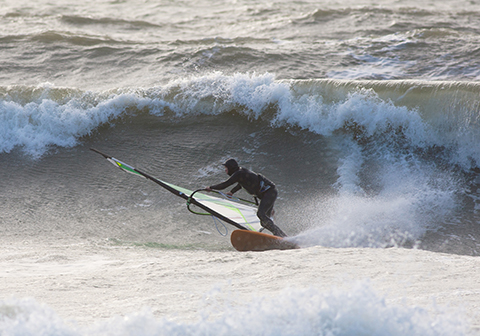
// Paul ‘Monkey’ Metcalfe took a while to convert to multi-fins but after a change of style now fully embraces the concept – sailing the board more with the feet and less with the rig. “When it comes to riding in onshore winds,’’ he says, “it’s all about finding the peak.’’ Which is certainly much easier to do when you sail the same spot 4 days a week.
PHOTO Dave Gammon
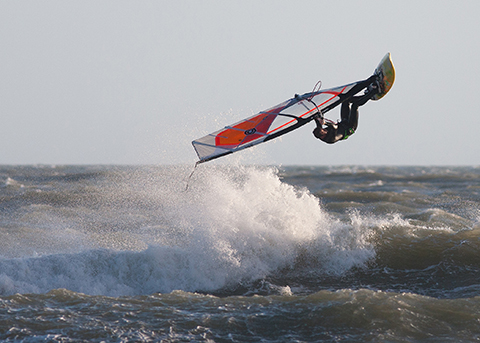
// “Short term pain for long term gain” is Dan Macaulay’s motto for getting out the back. Bear away, go for speed, which will help you over white water, lighten the sail and heighten your jumps. The less time you spend off the plane in the impact zone, the better your chance of victory.
PHOTO Dave Gammon
Sail size and setting
They’re right with the program having opted for 4 and 3 batten wave sails but have various things to say about setting and getting the right amount
of power.
EK I know the trend is for big board, small sail but I’m using more sail than I was 5 years ago. The extra power helps me gouge deeper and I like to go big on the jumps – and the best way to do that is more power and more speed.
Because Emile is fit and therefore a very early planer, his idea of ‘a lot more sail/power’ is about the same as a normal guy needs to get planing. He doesn’t carry a lot more sail than anyone else but makes better use of that power.
DM You need a lot more skin tension with a 4 batten sail or it just pulls like a cheap tractor (he actually used a less savory metaphor). But you still have to leave shape in them or you get that horrible on/off feel. I know that was the trend in dedicated wave sails so you depower easily and balance yourself in the lip – but I hate it, especially in onshore winds when you always need power.
PM The thing I change the most is boom height. I need to feel that balance between feet and mastfoot and it usually takes about 3 runs to get it just right.
IW One mistake people make down here is to go too small on sail size. I think it’s because onshore winds make the sea look windier than it is. That’s the main reason so many of them end up downwind.
And that leads us nicely onto …
STAYING UPWIND
With both wind and wave driving you back to the shore, staying upwind in onshore conditions is a constant tactical and technical challenge. Confidence in that one area brings about huge changes. What have the boys learned? Emile kicks us off controversially …
EK Some are so worried about the dreaded ‘walk of shame’ that they never bear away to ride or jump or do anything. I often walk upwind. It’s NOT a walk a shame – it’s just a useful tactic for getting back!
Indeed a walk can be a planned part of the ride. On Magheroarty beach in Ireland, on big days you launch on the upwind end where the waves are small, sail out into the middle of the bay where huge waves are peaking on the reef, and then ride them all the way downwind into the apex of the bay where the shorebreak is thunderous. There’s no way you’d get back out through it, so you walk 300m upwind and start again. It’s a ‘stroll of tactical joy.’
IW Long lines (30”) make a big difference. They allow you to stand forward and sail off the front foot and use the heel to keep the rail in. Obviously try and use the wave to carry you back up – but make sure the wave is taking you where you want. In onshore winds, the swells out to sea roll dead downwind. It’s only when they bend into the beach that they carry you upwind.
EK If you try and sail too high too slowly, the direction the board is pointing won’t be the same as the direction of travel.
GETTING OUT – the white water/current issue
Losing it in and around the impact zone is the most disheartening onshore wind activity. Recovering the rig and waterstarting between barrages is a nightmare. Getting washed towards shore means losing valuable yards downwind – and the whole swimming/recovery exercise is exhausting, especially in winter.
There’s the technique and skill of actually staying upright as the foam tries to bury both you and kit. But as important are the tactics, knowing where to launch and which line to take.
DM Think “short term pain for long term gain.” Really go for it. A lot of people try and squeak upwind through the white water off the plane. Sometimes you have to if it’s really onshore but the longer you hang around in the foam zone, the greater the chance of getting worked. Foot off in the first gust, sail really fast downwind and use speed to head up over the white water – and with that speed you get your apparent wind going and the jumps are easier to control.
I’ve noticed that most of the group now take the ‘pro’ line out through the surf, sailing almost parallel with the beach to get going before heading up. It comes from their confidence to get back upwind, but also from understanding that because of the way the wind bends towards the shore (effectively making it more onshore by the beach), sailing parallel with the beach is not as broad to the wind as you think. It’s a game of chess.
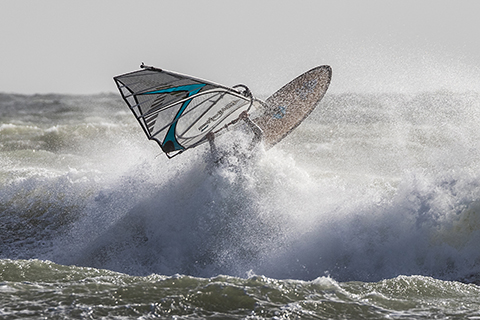
// On big onshore days, especially in winter, falling and losing gear in the impact zone lands you downwind, saps your energy and should not be an option. Fight it! Harty takes a deep breath and hangs on.
PHOTO Bill Wyatt
RIDING IN ONSHORE
Everyone in the Joliffe group rides waves downwind – not just bearing away into the trough – but proper bottom and top turns with a degree of commitment that makes the conditions look a lot friendlier than they are. There’s no one line; no one golden, cure-all method but here to finish are some top reflections from the team.
PM You can’t do anything without a peak to work with. What’s helped me more than anything is predicting where that peak is going to be. The main technique challenge is opening the sail to that switch foot clew first position. It helps to see the bottom turn as a gybe – and in a gybe you know you’re doing good when on the exit you can see where you’re going – and in the case of wave sailing, see the wave past the clew. I’ve found going for the one handed top turn, where you move the back hand forward and release the front hand, helps you keep the sail open and stops you over-sheeting.
IW It’s all about the wave for me. I keep sailing upwind as far as possible looking for that lip. I’m not afraid of it. I know the steeper and punchier the wave, the better my ride is going to be.
EK You’ve got to make your turns tight in onshore winds. Think where the board is pointing. So many people only get parallel with the wave. To keep tuning you have to be flexible to keep opening and really load the clew.
DM Drop late and turn tight – that’s my motto. One line I used to take was to go for a backside ‘snap’ top turn and use that as a platform to bear off down-the-line. But it means you’re starting almost stationary. I learned a lot from watching Jamie Hawkins who would scream upwind at the top of the wave and then rather than stopping and pivoting would take that speed and just drop straight into a tight bottom turn. It’s easy to blow it, but when it works …
A good top turn is simply a function of a good bottom turn, so the more speed you carry the better. For me wave-riding in onshore is all about using the wave. It only feels good if you get vertical and let the wave redirect you.
I see people getting a bit ambitious with their bottom turns in small waves, trying to lay the sail down – but there isn’t time to get it back up for the top turn. With the wide tail multi-fins, you have to really stamp it round rather than draw the turn out. To get speed through the bottom turn it’s more about leaning the sail forward than down.
All that and we haven’t even gone into the activity which onshore winds were designed for – jumping. Another time!
Special thanks to Bill Wyatt who provided two of the shots in this piece. Bill has worked in many areas of sports broadcasting and you can see his work on www.billwyatt.com. And many thanks also to Dave Gammon, legendary south coast sailor and photographer.
Harty has a fabulous new website www.peter-hart.com revealing news of everything windsurfing including spaces on up and coming clinics. Email him for his monthly newsletter on [email protected] or like his Peter Hart Masterclass page.


